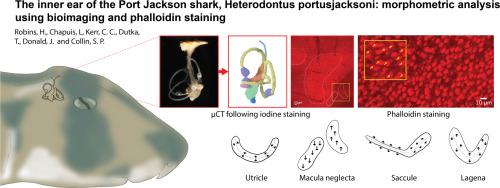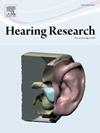杰克逊港鲨的内耳,异齿鲨portusjacksoni:使用生物成像和生殖器素染色的形态计量学分析
IF 2.5
2区 医学
Q1 AUDIOLOGY & SPEECH-LANGUAGE PATHOLOGY
引用次数: 0
摘要
内耳在硬骨鱼的声音探测和平衡中起着至关重要的作用,但与硬骨鱼相比,内耳的形态学和功能仍未得到充分研究。本研究首次对杰克逊港鲨(Heterodontus portusjacksoni)的内耳进行了详细的形态学分析,方法包括显微计算机断层扫描(µCT)、精细解剖和黄斑毛细胞的生殖器激素标记。关键结构的测量,包括球囊、球囊、胞室和半规管,从不同生命阶段的个体中获得。使用phalloidin染色和共聚焦显微镜定量毛细胞密度和取向,以评估潜在的听觉和前庭特化。忽略黄斑,一种在蓝鳃目动物中与方向性听力相关的结构,但以前未在该物种中发现,存在但相对较小,毛细胞密度低,与H. portusjacksoni的底栖生活方式一致。研究结果表明,这种物种更多地依赖于基质振动和空间稳定性,而不是敏锐的定向听觉,这与它们在波浪暴露的岩石珊瑚礁栖息地的生态一致。这些发现有助于理解板颌目的感觉适应,并强调了进一步研究人为声音对板颌目听觉系统影响的必要性。本文章由计算机程序翻译,如有差异,请以英文原文为准。

The inner ear of the Port Jackson shark, Heterodontus portusjacksoni: morphometric analysis using bioimaging and phalloidin staining
The inner ear plays a crucial role in detecting sound and maintaining balance in elasmobranchs, yet its morphology and function remain poorly understudied compared to teleosts. This study provides the first detailed morphometric analysis of the inner ear in the Port Jackson shark Heterodontus portusjacksoni using micro-computed tomography (µCT), fine dissection, and phalloidin labelling of macular hair cells. Measurements of key structures, including the saccule, lagena, utricle, and semicircular canals, are obtained from individuals across different life stages. Hair cell density and orientation are quantified using phalloidin staining and confocal microscopy to assess potential auditory and vestibular specialisations. The macula neglecta, a structure associated with directional hearing in elasmobranchs but not previously identified in this species, is present but relatively small, with low hair cell density, consistent with the benthic lifestyle of H. portusjacksoni. The findings suggest that this species relies more on substrate-borne vibrations and spatial stability than on acute directional hearing, aligning with its ecology in wave-exposed, rocky reef habitats. These findings contribute to the understanding of sensory adaptations in elasmobranchs and highlight the need for further research on the impacts of anthropogenic sound on elasmobranch auditory systems.
求助全文
通过发布文献求助,成功后即可免费获取论文全文。
去求助
来源期刊

Hearing Research
医学-耳鼻喉科学
CiteScore
5.30
自引率
14.30%
发文量
163
审稿时长
75 days
期刊介绍:
The aim of the journal is to provide a forum for papers concerned with basic peripheral and central auditory mechanisms. Emphasis is on experimental and clinical studies, but theoretical and methodological papers will also be considered. The journal publishes original research papers, review and mini- review articles, rapid communications, method/protocol and perspective articles.
Papers submitted should deal with auditory anatomy, physiology, psychophysics, imaging, modeling and behavioural studies in animals and humans, as well as hearing aids and cochlear implants. Papers dealing with the vestibular system are also considered for publication. Papers on comparative aspects of hearing and on effects of drugs and environmental contaminants on hearing function will also be considered. Clinical papers will be accepted when they contribute to the understanding of normal and pathological hearing functions.
 求助内容:
求助内容: 应助结果提醒方式:
应助结果提醒方式:


